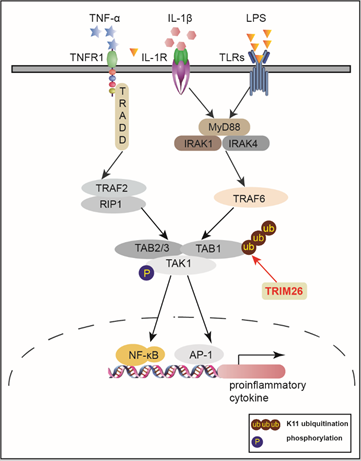Recently, Professor Gao Chengjiang's team in the School of Basic Medical Sciences of Shandong University has published a research paper entitled "TRIM26 positively regulates the inflammatory immune response through K11-linked ubiquitination of TAB1" online in Cell Death & Differentiation (IF:10.717). Zhao Jian and Cai Baoshan, PhD students from the School of Basic Medical Sciences of Shandong University, are the co-first authors of this paper. Professor Gao Chengjiang and assistant researcher Liu Bingyu from the School of Basic Medical Sciences of Shandong University are the corresponding authors of this paper. Shandong University is the first author institute and the sole corresponding author institute. This research is supported by Professor Yi Fan and Professor Ma Chunhong.

Innate immunity provides the first line of host defense against microbial invading pathogens. Toll-like receptors (TLRs) are among the first pattern-recognition receptors to be identified as playing an essential role in the innate immune response. Upon stimulated with these ligands, myeloid differentiation primary response gene 88 (MyD88) and Toll/IL-1R domain-containing adaptor that induces an IFN-β (TRIF) are recruited to the Toll/IL-1R domain located in the cytoplasmic tails of TLRs. MyD88/TRIF then combines with IL-1R-associated kinase 1/4 (IRAK1/4) to promote the activation of TNFR-associated factor (TRAF) 6 and transforming growth factor-activated kinase 1 (TAK1), leading to the activation of NF-κB and MAPK. Excessive activation of TLRs signaling can cause inflammatory diseases, such as autoimmunity, chronic inflammation, or allergy.Thus, the TLRs-mediated inflammatory response must be tightly controlled.
The team of Professor Gao Chengjiang has identified several members of the TRIM protein family like TRIM31, TRIM26 and TRIM38, which involved in antiviral innate immune response (Nat Immunol 2017, 18:214-224; PLoS Pathog 2015, 11: e1004726, J Immunol 2012, 188:5311-5318; J Immunol 2012, 188:2567-2574). While the role of TRIM protein family ininflammatory response is not clear,in this study, we found TRIM26 plays a key role in TLRs-inducedinflammatory response andTRIM26 deficiency protects mice from LPS-induced septic shockin vivo.A further study revealed that TRIM26 induced a nonclassical polyubiquitination, K11-linked polyubiquitination of TAB1, which led to TAK1 phosphorylation and the subsequent transcription of proinflammatory cytokines.Thus, our study revealed a new mechanism underlying phosphorylation and activation of TAK1 mediated by TRIM26 catalyzing K11-linked polyubiquitination of TAB1 in the TLRs-mediated inflammatory response. TRIM26 may serve as a potential target for new therapeutic interventions against inflammation-associated diseases.
The research group of Professor Gao Chengjiang of the School of Basic Medical Sciences, Shandong University has long been concerned about theinnate immune responses andinflammatory response. Relevant research results were published atNature Immunology,Journal of Experimental Medicine, Nature Communications,PLOS Pathogenset al.This work was supported by the Innovative Research Group Project of Shandong University. This work was also supported by the Natural Science Foundation of China and the Postdoctoral Science Foundation of China.